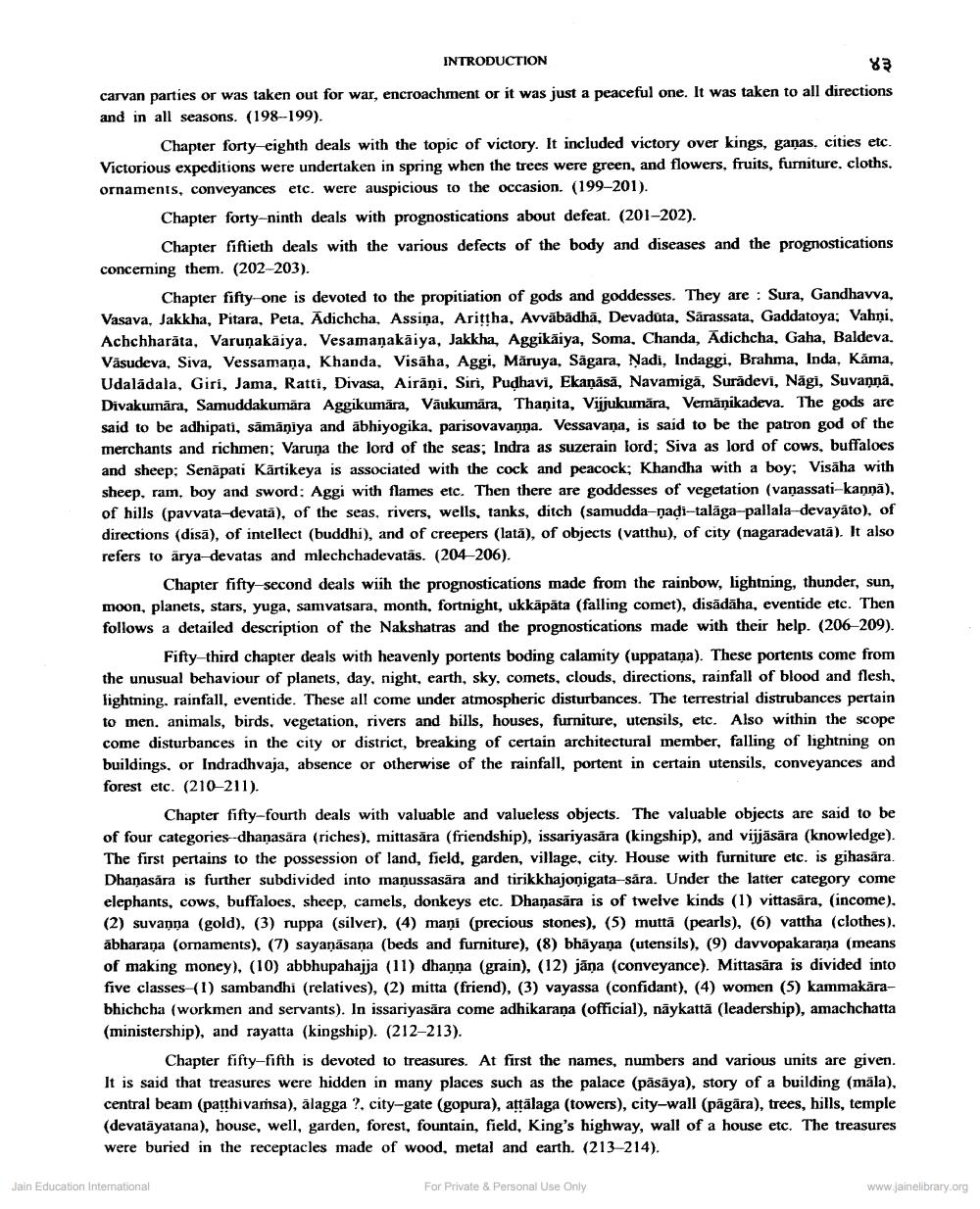________________
INTRODUCTION
carvan parties or was taken out for war, encroachment or it was just a peaceful one. It was taken to all directions and in all seasons. (198--199).
Chapter forty-eighth deals with the topic of victory. It included victory over kings, ganas, cities etc. Victorious expeditions were undertaken in spring when the trees were green, and flowers, fruits, furniture, cloths. ornaments, conveyances etc. were auspicious to the occasion. (199-201).
Chapter forty-ninth deals with prognostications about defeat. (201-202).
Chapter fiftieth deals with the various defects of the body and diseases and the prognostications concerning them. (202-203).
Chapter fifty-one is devoted to the propitiation of gods and goddesses. They are : Sura, Gandhavva, Vasava, Jakkha, Pitara, Peta. Adichcha, Assiņa, Arittha, Avvābādhā, Devaduta, Särassata, Gaddatoya; Vahni, Achchharăta, Varuņakäiya. Vesamanakaiya, Jakkha, Aggikāiya, Soma, Chanda, Adichcha, Gaha, Baldeva. Väsudeva, Siva, Vessamana, Khanda, Visāha, Aggi, Māruya, Sāgara, Nadi, Indaggi, Brahma, Inda, Kāma, Udaládala, Giri, Jama, Ratti, Divasa, Airāņi, Siri, Pudhavi, Ekaņāsā, Navamiga, Suradevi, Nägi, Suvannā, Divakumnāra, Samuddakumara Aggikumāra, Vāukumāra, Thanita, Vijjukumăra, Vemāņikadeva. The gods are said to be adhipati, sámániya and abhiyogika, parisovavanna. Vessavana, is said to be the patron god of the merchants and richmen; Varuna the lord of the seas; Indra as suzerain lord; Siva as lord of cows, buffaloes and sheep: Senapati Kartikeya is associated with the cock and peacock; Khandha with a boy: Visäha with sheep, ram, boy and sword: Aggi with flames etc. Then there are goddesses of vegetation (vanassati-kanna), of hills (pavvata-devata), of the seas, rivers, wells, tanks, ditch (samudda-nadi-talaga-pallala-devayato), of directions (disā), of intellect (buddhi), and of creepers (latā), of objects (vatthu), of city (nagaradevata). It also refers to ärya devatas and mlechchadevatás. (204-206).
Chapter fifty-second deals wiih the prognostications made from the rainbow, lightning, thunder, sun, moon, planets, stars, yuga, samvatsara, month, fortnight, ukkāpata (falling comet), disādäha, eventide etc. Then follows a detailed description of the Nakshatras and the prognostications made with their help. (206-209).
Fifty-third chapter deals with heavenly portents boding calamity (uppataņa). These portents come from the unusual behaviour of planets, day, night, earth, sky, comets, clouds, directions, rainfall of blood and flesh, lightning, rainfall, eventide. These all come under atmospheric disturbances. The terrestrial distrubances pertain to men, animals, birds, vegetation, rivers and bills, houses, furniture, utensils, etc. Also within the scope come disturbances in the city or district, breaking of certain architectural member, falling of lightning on buildings, or Indradhvaja, absence or otherwise of the rainfall, portent in certain utensils, conveyances and forest etc. (210-211).
Chapter fifty-fourth deals with valuable and valueless objects. The valuable objects are said to be of four categories -dhanasara (riches), mittasära (friendship), issariyasära (kingship), and vijjäsara (knowledge). The first pertains to the possession of land, field, garden, village, city. House with furniture etc. is gihasära. Dhanasára is further subdivided into manussasāra and tirikkhajonigata-sära. Under the latter category come elephants, cows, buffaloes, sheep, camels, donkeys etc. Dhaņasāra is of twelve kinds (1) vittasára, (income). (2) suvanna (gold), (3) ruppa (silver), (4) mani (precious stones), (5) mutta (pearls), (6) vattha (clothes). abharana (ornaments), (7) sayanāsana (beds and furniture), (8) bhāyana (utensils), (9) davvopakarana (means of making money), (10) abbhupahajja (11) dhanna (grain), (12) jāna (conveyance). Mittasāra is divided into five classes (1) sambandhi (relatives), (2) mitta (friend), (3) vayassa (confidant), (4) women (5) kammakārabhichcha (workmen and servants). In issariyasāra come adhikarana (official), nāykattā (leadership), amachchatta (ministership), and rayatta (kingship). (212-213).
Chapter fifty-fifth is devoted to treasures. At first the names, numbers and various units are given. It is said that treasures were hidden in many places such as the palace (pāsāya), story of a building (mäla), central beam (patthivamsa), alagga ?, city-gate (gopura), attālaga (towers), city-wall (pägära), trees, hills, temple (devatäyatana), house, well, garden, forest, fountain, field, King's highway, wall of a house etc. The treasures were buried in the receptacles made of wood, metal and earth. (213-214).
Jain Education International
For Private & Personal Use Only
www.jainelibrary.org




